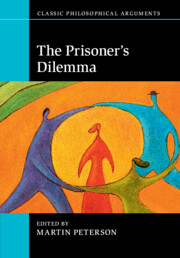Book contents
- Frontmatter
- Contents
- List of contributors
- Introduction
- 1 Why all the fuss? The many aspects of the Prisoner's Dilemma
- 2 How I learned to stop worrying and love the Prisoner's Dilemma
- 3 Taking the Prisoner's Dilemma seriously: what can we learn from a trivial game?
- 4 Prisoner's Dilemma doesn't explain much
- 5 The Prisoner's Dilemma and the coevolution of descriptive and predictive dispositions
- 6 I cannot cheat on you after we talk
- 7 Prisoner's Dilemma cannot be a Newcomb Problem
- 8 Counterfactuals and the Prisoner's Dilemma
- 9 The Tragedy of the Commons as a Voting Game
- 10 The role of numbers in Prisoner's Dilemmas and public good situations
- 11 The inner struggle: why you should cooperate with people you will never meet again
- 12 Prisoner's Dilemmas, intergenerational asymmetry, and climate change ethics
- 13 Prisoner's Dilemma experiments
- 14 The lesson of the Prisoner's Dilemma
- Bibliography
- Index
Introduction
Published online by Cambridge University Press: 05 July 2015
- Frontmatter
- Contents
- List of contributors
- Introduction
- 1 Why all the fuss? The many aspects of the Prisoner's Dilemma
- 2 How I learned to stop worrying and love the Prisoner's Dilemma
- 3 Taking the Prisoner's Dilemma seriously: what can we learn from a trivial game?
- 4 Prisoner's Dilemma doesn't explain much
- 5 The Prisoner's Dilemma and the coevolution of descriptive and predictive dispositions
- 6 I cannot cheat on you after we talk
- 7 Prisoner's Dilemma cannot be a Newcomb Problem
- 8 Counterfactuals and the Prisoner's Dilemma
- 9 The Tragedy of the Commons as a Voting Game
- 10 The role of numbers in Prisoner's Dilemmas and public good situations
- 11 The inner struggle: why you should cooperate with people you will never meet again
- 12 Prisoner's Dilemmas, intergenerational asymmetry, and climate change ethics
- 13 Prisoner's Dilemma experiments
- 14 The lesson of the Prisoner's Dilemma
- Bibliography
- Index
Summary
0.1 An ingenuous example
The Prisoner's Dilemma is one of the most fiercely debated thought experiments in philosophy and the social sciences. Unlike many other intellectual puzzles discussed by academics, the Prisoner's Dilemma is also a type of situation that many of us actually encounter in real life from time to time. Events as diverse as traffic jams, political power struggles, and global warming can be analyzed as Prisoner's Dilemmas.
Albert W. Tucker coined the term “Prisoner's Dilemma” during a lecture in 1950 in which he discussed the work of his graduate student John F. Nash. Notably, Nash won the Nobel Prize in Economics in 1994 and is the subject of the Hollywood film A Beautiful Mind (which won four Academy Awards). If this is the first time you have come across the Prisoner's Dilemma, I ask you to keep in mind that the following somewhat artificial example is just meant to illustrate a much more general phenomenon:
Two gangsters, Row and Col, have been arrested for a serious crime. The district attorney gives them one hour to either confess or deny the charges. The district attorney, who took a course in game theory at university, explains that if both prisoners confess, each will be sentenced to ten years in prison. However, if one confesses and the other denies the charges, then the prisoner who confesses will be rewarded and get away with serving just one year. The other prisoner will get twenty years. Finally, if both prisoners deny the charges, each will be sentenced to two years. The prisoners are kept in separate rooms and are not allowed to communicate with each other. (The significance of these assumptions will be discussed at the end of this section.)
The numbers in Figure 0.1 represent each prisoner's evaluation of the four possible outcomes. The numbers −1, −20 mean one year in prison for Row and twenty years for Col, and so on. Naturally, both prisoners prefer to spend as little time in prison as possible.
The Prisoner's Dilemma has attracted so much attention in the academic literature because it seems to capture something important about a broad range of phenomena.
- Type
- Chapter
- Information
- The Prisoner's Dilemma , pp. 1 - 15Publisher: Cambridge University PressPrint publication year: 2015



